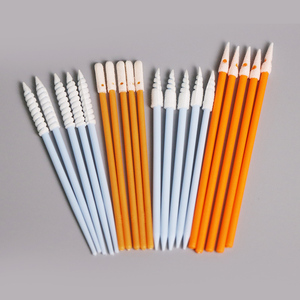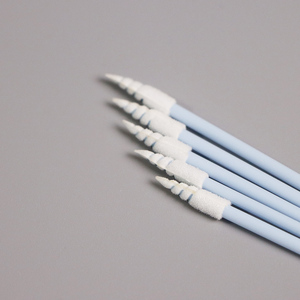(2073 products available)













































































































































































































A clean sponge swab is a cleaning tool used in different industries for cleaning, applying, and removing substances. They come in different sizes and shapes and are made from different materials to meet specific cleaning and application needs. The types of clean sponge swab can be classified as follows.
Medical Swab
Medical sponge swabs are used for cleaning wounds, applying medication, and collecting samples for tests. They are designed to be gentle on the skin and prevent cross-contamination. Medical swabs can be made of cotton or synthetic materials, and they have different sizes and shapes to suit various medical applications.
Cosmetic Swab
Cosmetic swabs are used for makeup application, skincare, and cleansing. They are designed to be gentle on the skin and help maintain hygiene during beauty routines. Clean sponge cosmetic swabs come in various sizes and can be used for precise applications like lipstick or lip gloss.
Industrial Swab
Industrial sponge swabs are used for cleaning and applying chemicals in laboratories, manufacturing plants, and other industrial settings. They are designed to remove dirt, grease, and contaminants from tools, equipment, and surfaces. Industrial swabs come in different sizes and shapes to meet the needs of various industrial applications.
Environmental Swab
Environmental sponge swabs are used for sampling and testing environmental surfaces, soil, and water. They are designed to collect contaminants and analyze pollutants. Environmental swabs can be made of different materials and have different sizes and shapes to suit various environmental applications.
These are just a few examples of the many types of clean sponge swab that are available. Each type is designed for a specific purpose and offers unique benefits. Depending on the application, one may prefer a cotton swab for its softness, a foam swab for its absorbency, or a wooden stick swab for its sturdiness.
Double-ended clean sponge swabs have a simple yet effective design. Each swab has two ends, each with a sponge. This double-ended feature gives users more options for cleaning with one tool. The swabs are usually thin and stick-like in shape. This shape allows users to hold them easily and reach into small spaces or tight spots without difficulty. The sponges on the ends are small but mighty. They can clean dirt, dust, and other debris from various surfaces. Some swabs have firm sponges that do deep cleaning. Others have soft, flexible sponges that are gentle and do light cleaning. This variety makes them good for different cleaning tasks. The handles are often made of wood or plastic. Both materials are sturdy and bend-resistant but still light. This makes the swabs durable for repeated use without adding much weight, which keeps them portable.
To ensure cleanliness and safety, many suppliers of clean sponge swabs produce them in a clean and safe manner. They package the swabs so that no dirt can get in before they are opened for use. This packaging keeps the swabs clean and safe until needed. Some swabs also have features for better cleaning and user experience. For example, some designs have absorbent sponges. These sponges soak up liquids well, making them great for cleaning spills or applying liquids. Other designs have non-abrasive sponges that are gentle on all surfaces, reducing the risk of scratches or damage during cleaning.
Cotton swabs have many applications. Some of them are as follows:
Medical Applications:
In the medical field, clean sponge swabs are used for skin cleansing. It is done before injections or surgical procedures. They help collect samples for tests. Examples include blood, throat, or wound cultures. Medical swabs are used for specimen collection. They help diagnose infections or conditions. They are also used in blood collection, wound care, and applying ointments or medications.
Cosmetic and Personal Care:
In the beauty industry, sponge swabs are used for makeup application and touch-ups. They reach small or detailed areas. They can clean and exfoliate the skin. They are used in facial treatments and makeup removal. Clean sponge swabs are essential for maintaining personal hygiene. They help clean ears, apply creams, and remove makeup.
Industrial and Laboratory Use:
In labs, clean sponge swabs are used to collect samples from surfaces. They can be tested for contaminants. They are used for precision cleaning of delicate instruments. They are used in electronics, optics, and other sensitive fields.
Environmental Monitoring:
Sponge swabs are used to sample surfaces in environmental studies. They can detect pollutants or pathogens. This helps assess environmental quality. They help ensure safety in different settings.
Food Industry:
Sponge swabs are used in the food industry to sample surfaces. This helps check for cleanliness and to pathogens. They are used in the preparation of food samples. This is to test for contaminants in the laboratory.
Research:
Clean sponge swabs are used in various research applications. They help in specimen collection, sample preparation, and cleaning.
Product Description:
When choosing a clean sponge swab, it is important to consider the product description. The product description contains important information about the swab, including what it is made of, how big it is, and what it can be used for. By reading the product description, one can determine if the sponge swab is suitable for one's needs. For example, if one needs a swab that can be used on sensitive skin, one should look for one made of soft material. Considering the product description helps one choose a clean sponge swab that is appropriate for the tasks one intends to use it for.
Material:
When selecting a clean sponge swab, the material is an important consideration. Sponge swabs are typically made from different materials, each with its advantages. For delicate tasks or surfaces, one may prefer a soft foam material that will not cause damage. If durability and resistance to chemicals are priorities, selecting a swab made from a robust non-woven fabric may be more appropriate. The choice of material should align with the intended use of the sponge swab to ensure effectiveness and safety.
Size and shape:
Size and shape are important factors to consider when choosing a clean sponge swab. Different tasks may require different sizes and shapes of swabs. For example, small and pointed swabs may be needed for precise work in tight spaces, while larger ones may be more suitable for covering bigger areas quickly. Considering the size and shape that one's tasks demand ensures that sponge swabs are convenient and effective for use.
Packaging:
When choosing a clean sponge swab, people should pay attention to the packaging. Manufacturers often package sponge swabs in a way that preserves their cleanliness and prevents contamination. Individually sealed packaging allows each swab to remain sterile until use, which is especially important for medical or laboratory applications where cleanliness is crucial. Even if packaged together, the packaging should be designed to keep the swabs clean and protect them from dirt. Considering the packaging helps ensure that the sponge swabs stay clean and maintain their hygienic quality until needed.
Q1. What is a clean sponge swab?
A1. A clean sponge swab is a tool used for cleaning and applying substances. It usually has a handle and a head covered with absorbent material. This head can be a sponge or fabric. These tools are used to clean surfaces, apply liquids, or reach into small spaces.
Q2. What are the benefits of using clean sponge swabs?
A2. One major benefit of using clean sponge swabs is their ability to hold and control liquids effectively. This property allows for precise application or removal of cleaning agents, solvents, or solutions, making them ideal for delicate tasks. Additionally, their soft and absorbent nature ensures thorough yet gentle cleaning, reducing the risk of damage to fragile surfaces.
Q3. What do people use clean sponge swabs for?
A3. These tools are used in many industries for cleaning, applying, and sampling. They are used in labs to clean glassware, in electronics to clean circuit boards, and in healthcare to collect samples and clean wounds.
Q4. What makes a clean sponge swab?
A4. Swabs can be made from different materials. The choice of material depends on the intended use of the swab. Cotton is soft and flexible, making it suitable for applications on the skin or for collecting samples. Foam has a uniform structure that resists chemicals and solvents. It is used in cleaning and applying chemicals. Polyester is durable and can be sterilized. It is used in medical and electronic applications.
Q5. Why are clean sponge swabs important?
A5. Clean sponge swabs are important because they help prevent cross-contamination. They are packaged in clean, sealed packs to maintain their sterility until use. This feature is particularly important in healthcare and laboratories, where the introduction of contaminants can have serious consequences.